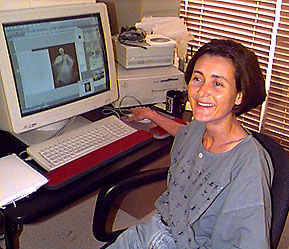
|
|
We had just finished taping a temporary sound track. It was done
to evaluate how long it would take to complete the narration of
the story that would run alongside the pictures for the CD ROM
" I Photograph to Remember". The fact that the sound which the viewer could listen to on that CD ROM, was a "warts and all" version, provided a quality of realism and integrity that was widely recognized as a real contribution to the overall presentation. My inability to retape the whole story, turned out to be a real blessing. Ifound that having the sound -my voice- next to the images, provided a very important layer of information, which would have been missing in a printed version of such work. I don't say "missing" in the obvious sense that it was not there, but in the emotional impact that it produced on the viewer to be able to listen to my voice at the same time as looking at the pictures. Sound was not something that we as still photographers had to deal with in the past, we had been trained to see, not to hear. After all the possible output for our still pictures, like in the silent movies, was a space without sound. Images on paper, or prints on a wall. With the advent of the CD ROM technology, which enabled one to publish pictures alongside a sound track, all that changed for ever. " I Photograph to Remember" published by Voyager, became the first CD ROM that had been published anywhere that had continuous sound and images, both being digital. Now photographers could create sound tracks that did not require access to very complicated sound installations. It could be done with modest resources and on personal computers. Over the past year the internet developed the delivery of sound with an ever increasing level of quality. This convinced us that we should be involved with this effort here at ZoneZero. We think that the time has come when still photographers will explore more and more the possibilities that are offered by having sound next to their images. We believe that in the future, still pictures will be seen as either "silent" or "talking" pictures, much as in the movies. After all we now have the technology to deliver and produce such options at very reasonable costs. We feel that from a technical perspective there will be a convergence of digital still and video options, with both having access to sound tracks. In time we shall have been as influenced by such new "cameras" as was the 35 mm format in it's time. In line with our committment to use sound, we encouraged Muriel Hasbun, to develop her work, which we are presenting here in ZoneZero at this time. We urged her to tape a sound track to go along with her very powerful and moving story. We believe she has created something quite important which, aside of it's artistic merits, is probably among the first such examples that have appeared on the Internet. With this example we hope to encourage many others to follow such a direction, as we believe this will provide photography with yet another new option with which to expand it's story telling potential . As time moves on, the technologies available will surely provide us with more seamless and sophisticated delivery systems. But the essence will remain the same. Still pictures and sound have finally come together in a readily transportable medium. Pedro Meyer |
